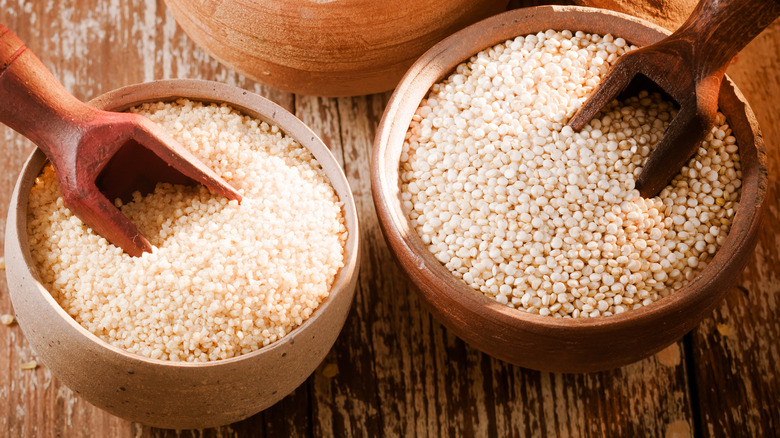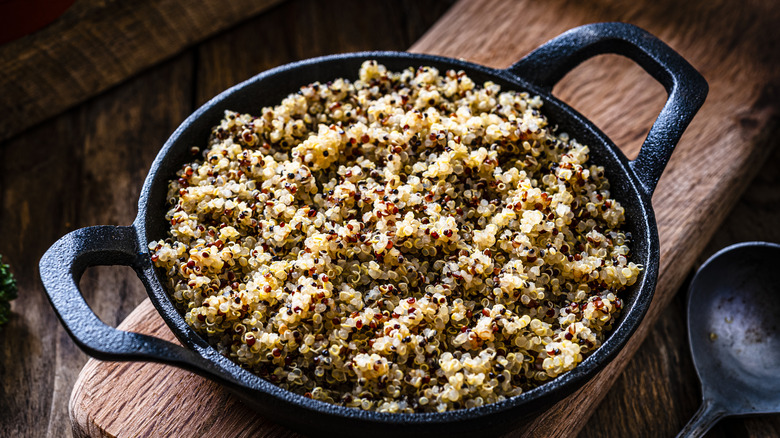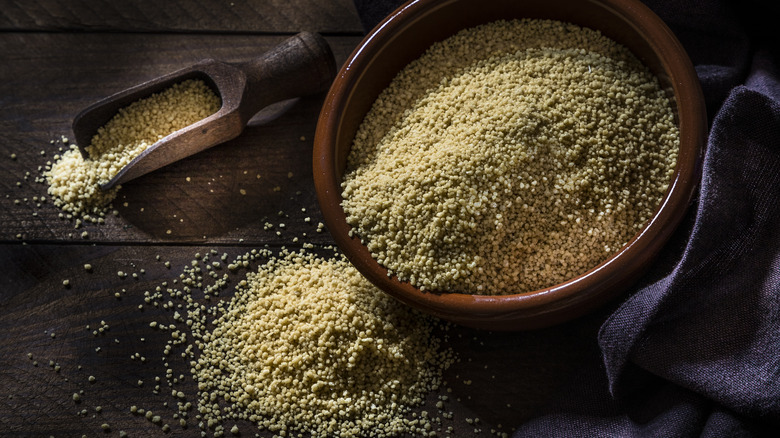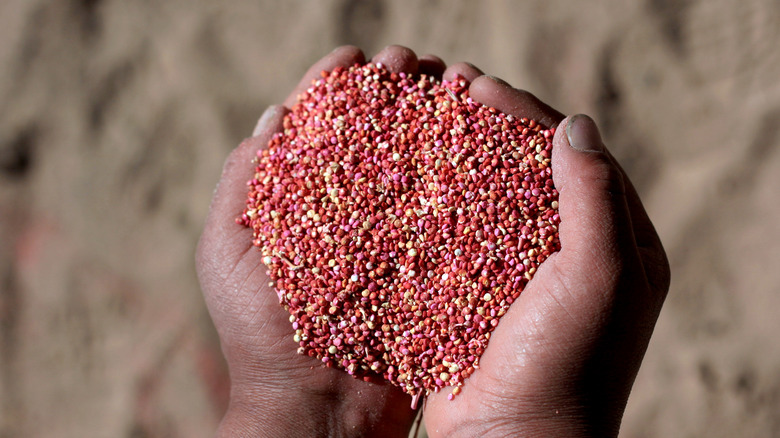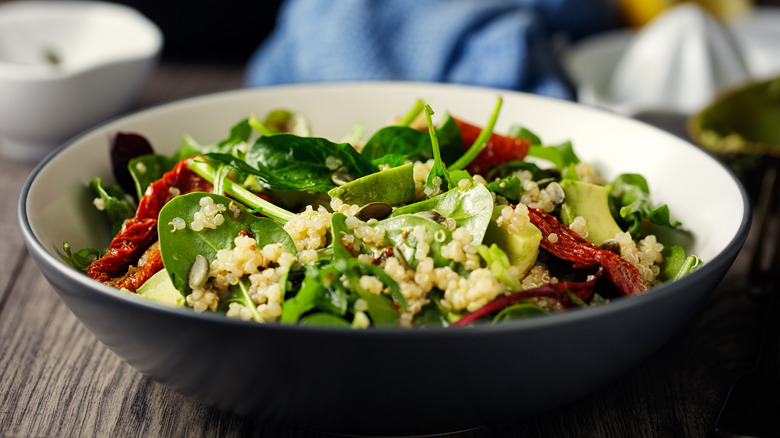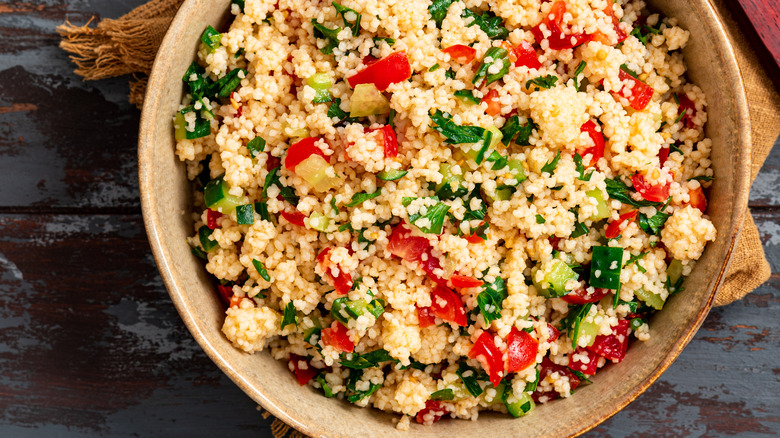The Difference Between Quinoa And Couscous
Pasta, rice, and potatoes are delicious, but they're only the tip of the iceberg of filling carbs. For easy and quick-to-make alternatives, turn to the delightful couscous and quinoa. Commonly confused — and incorrectly categorized as grains — the two foods have distinct attributes. Hailing from separate continents, they have varying uses, nutritional qualities, and subtle differences in taste, too.
When choosing between the two foods, there's not one that's better than the other. Both are delicious and satiating, with a dizzying amount of applications. Interest in South American foods, as well as Mediterranean cuisine, has deservedly amplified the two foods into the culinary spotlight. However, each comes with its own advantages and culinary quirks. When considering how to integrate each food into the diet, it pays to look at the particulars — especially for those concerned with gluten intake. Let's dive into the differences between quinoa and couscous.
What is quinoa?
Quinoa is a standalone plant species in the Amaranthaceae family (along with beets and chard), which has edible leaves as well as the more widely consumed internal seeds. Native to the Andes mountains in South America, it's especially linked with Peru and Bolivia, where the majority of production continues to occur. Eaten for over 7,000 years, the pseudo cereal is an excellent nutritional source. Packed with fiber, fats, and vitamins, it also contains all nine complete amino acids, which makes it especially noted as a good food for vegetarians, notes Healthline.
Accelerated by its health benefits, quinoa has recently experienced a rapid rise in popularity. However, in addition to its nutrition, it's also delicious. After the bitter outside of the seed is removed, it's then cooked in water, much like rice. Quinoa's flavor is mild, with a delicate nuttiness and soft, yet chewy texture. It can then be served in everything from bowls, salads, and as a standalone side, as well as reworked into vegan burgers, puddings, and more.
What is couscous?
Tiny, fluffy, and delicious, couscous is technically a type of pasta, since it's made from semolina and other types of wheat flour. Hailing from North Africa, it's very popular throughout the region, as well as in the Middle East. It's found in three types: Moroccan, Israeli, and Lebanese couscous, with differences in size and texture. Couscous is gaining popularity in the U.S. due to how easy it is to prepare and the delicious results. Many varieties come together with a quick steam in boiling water, ready to use in only a couple of minutes. However, traditional Moroccan couscous versions can need several steaming cycles in a couscoussier.
Couscous has a gentle flavor that won't overwhelm any foods paired with it. Combined with a soft, but not mushy texture, it's easy to integrate into meals. It can be served with stews, in soups, as a base for salads, or as a simple side. It sops up any seasoning, melding with spicy, sour, and sweet flavors, meaning it can even be prepared for dessert. This convenience, matched with malleability, makes it a well-loved food the world over.
Quinoa and couscous offer different nutritional benefits
The most notable difference in composition between the two foods is the presence of gluten. As part of the pasta umbrella, couscous contains the type of protein that causes irritation for many individuals. Meanwhile, quinoa is naturally gluten-free, making it one of the best alternatives for those with sensitivities, notes Healthline.
In other aspects, the two foods each deliver distinct health benefits. A 100-gram serving of couscous delivers some 50% of the daily need for selenium, a metal beneficial for immune processes. Meanwhile, quinoa contains a range of antioxidants that have been found to reduce inflammation and prevent cancer risk. Both are foods with useful health qualities. However, quinoa does offer just a bit more potency. Per serving, it contains nearly 15% more protein, twice as much fiber, and twelve times more fat, which is comprised mostly of beneficial omega oils. Quinoa also boasts a higher composition of minerals such as manganese, folate, and iron, all the while containing fewer carbs, but more calories, according to Healthline. So, while couscous may still offer valuable health effects, quinoa packs in a bolder punch.
Quinoa vs. couscous in culinary uses
With a soft consistency and mild flavor, the two foods have abundant overlap in how they're used in the kitchen. They're both cooked in water and can be eaten hot and cold. They're popular in salads, mixed with chopped vegetables and dressings. They work well as sides to hearty stews, and both can be the base of dishes on their own, too. Just note that quinoa is slightly crunchier in texture, lending it a more robust consistency.
Both foods exist in several varieties, with quinoa processed into versatile formats. In addition to varying colors — each with a unique taste and texture — quinoa also exists as a flour, a flake, and a puff. As a result, quinoa can be the base of a pancake, part of a yogurt bowl, or even a nutritious addition to a smoothie. While it is possible to turn couscous into a delicious sweet pudding a little like a rice pudding, quinoa's multitude of textures lends it more dessert potential. Additionally, quinoa flour enables protein and fiber-rich, completely gluten-free baking.
Conversely, couscous has advantages in convenience. The popular instant variety has a short cooking time — under five minutes — while quinoa requires a minimum of 15. Additionally, couscous's pasta-like qualities may make it more approachable to some home cooks. It's easier to pair its flavor with other familiar components for a salad or a bowl. Try the Tasting Table lime-flavored black bean and couscous salad, for example.
Quinoa vs. couscous in availability and price
Quinoa and couscous are growing in global popularity at similar rates. Recent intrigue in quinoa's health qualities, as well as in Mediterranean cuisines, are reasons for interest in the U.S. So finding either is not difficult — many major grocers carry them, and they can be purchased online, too. In more remote areas, couscous edges out availability; quinoa is a more recent food arrival in the U.S.
The pricing depends on the variety. Both foods can be found at affordable costs — less than a dollar per serving. However, overall, couscous typically has a lower price. Additionally, since quinoa varietals depend on farming practices, the seed exists in rarer varieties. Bolivia's esteemed royal quinoa — noted for its taste and texture — fetches much higher prices than couscous types. Whether one, or ideally both, ends up in your pantry, there's no going wrong. With careful preparation, both foods will shine and deliver a delectable result.
